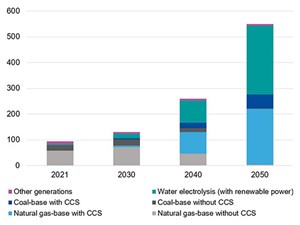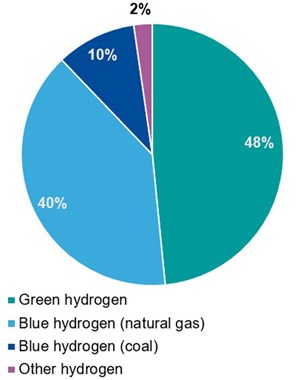Articles
Blue H2: A key player in the future of the energy transition
Blue/Green H2 Production
S. M. RAZAVI, Gas Exporting Countries Forum, Doha, Qatar
The energy sector is transforming, with a growing focus on cleaner energy sources and technologies that reduce greenhouse gas (GHG) emissions and contribute to a more sustainable future. In this context, hydrogen (H2) is emerging as a key player in the energy transition, with various clean production methods offering different advantages and competitiveness in the market.
The recent results of the Accelerated Energy Decarbonization Scenario (AEDS) provide valuable insights into the future of H2 as an energy vector.1 The results of the AEDS indicate that H2 has the potential to play a significant role in meeting future energy needs. The AEDS forecasts that H2 demand could reach 550 million tons (MMt) by 2050, making up nearly 10% of the total energy mix. This high demand for H2 reflects its compatibility as an energy vector and highlights the need for clean and more efficient H2 production.
Green H2 produced through water electrolysis using renewable power is expected to gain 48% of the output by 2050, with 270 MMt of production. This production level will require considerable electricity, estimated at 12,000 terawatt hours (TWh). This is equivalent to 43% of the current world annual electricity generation, or four times the current electricity generation from wind and solar, or the total current electricity generation in China and the U.S. combined.
Moreover, there will be a massive total requirement for renewable electricity generation forecasted at 46,000 TWh/yr from solar and wind in AEDS by 2050 due to higher electricity needs and decarbonization pathways such as electrification of the energy sectors. This massive amount of renewable power demand is more than 12 times higher than the current generation from wind and solar at around 3,600 TWh. The need for such a large amount of renewable power makes it imperative to consider a large share of H2 production from other available, competitive and mature methods, such as natural gas-based blue H2.
The AEDS expects around 220 MMt of H2 will be generated using natural gas with carbon capture and storage (CCS), accounting for 40% of total output by 2050. This level of H2 production will require more than 930 billion cubic meters (B3m) of natural gas by 2050. Coal gasification with CCS is expected to contribute around 10% or 54 MMt of H2 production by 2050 (FIGS. 1 and 2).


The cost competitiveness of these different H2 production methods is a key factor influencing market penetration and adoption. The cost of blue and green H2 varies depending on several factors such as location, production method and scale of production. Blue H2 is a more cost-competitive option than green H2, as it leverages the existing natural gas infrastructure and CCS technology. Presently, the average cost of blue H2 is estimated to be around $1.5/kilogram (kg) to $3/kg of H2, while the cost of green H2 is higher, ranging from $3/kg to $6/kg.
However, as renewable energy sources become cheaper and more widespread, green H2 is expected to enhance its cost-competitiveness and gain a large market share. The cost of green H2 production is expected to decrease by around 50% by 2030, making it competitive with blue H2 costs. Conversely, blue H2 is also expected to become cheaper as the technology for CCS improves and becomes more widely adopted. By 2050, it is estimated that the cost of green H2 will be similar to blue H2, making both options viable for widespread use in various industries.
It is important to note that the energy transition is not a one-size-fits-all solution, and various clean H2 production methods are necessary to meet future energy needs. In this context, the AEDS acknowledges the importance of considering all clean H2 production methods.
Takeaway. H2 is a crucial element in the energy transition, offering a clean and versatile energy source that significantly reduces GHG emissions and contributes to a more sustainable future. The results of the AEDS highlight the importance of considering all clean H2 production methods, including blue and green H2, in the future energy mix. The cost competitiveness of these different H2 production methods will be a key factor influencing their market penetration and adoption. The energy transition will likely involve combining clean H2 production methods tailored to specific energy needs and contexts.H2T
LITERATURE CITED
1 GECF, “Global gas outlook 2050 synopsis,” December 2022, online: https://www.gecf.org/_resources/files/flipbook/ggo2022fb/#1
About the author

SEYED MOHSEN RAZAVI is an Energy Technology Analyst at Gas Exporting Countries Forum (GECF), an international governmental organization that provides the framework for exchanging experience, information and ideas. Razavi has more than 16 yr of experience in the energy sector and has contributed as one of the leading authors to all six editions of the GECF’s flagship annual publication, Global Gas Outlook (GGO). As a member of the modeling team, he has developed many scenarios involving technologies such as CCUS and new energy vectors such as H2. Razavi has spent recent years developing editions of the GECF Hydrogen Scenario, which forecasts and analyzes the future of H2 demand, supply and trade. He has a background in energy systems engineering, a multidisciplinary program that includes energy modeling techniques and focuses on developing a view of analyzing integrated energy systems. Razavi has participated in several events to present the GGO’s findings and scenarios on the global energy transition and the role of H2.

